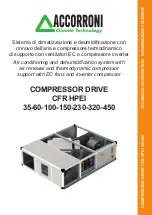
10
Application Engineering
B
U
L
L
E
T
I
N
AE4-1383 R5
© 2012 Emerson Climate Technologies, Inc.
Printed in the U.S.A.
No time delay is required on three phase models to
prevent reverse rotation due to brief power interruptions.
The CoreSense module will provide reverse rotation
protection.
Copeland Scroll Compressor Functional Check
Copeland Scroll compressors do not have internal
suction valves. It is not necessary to perform functional
compressor tests to check how the compressor will
pull suction pressure. This type of test may damage a
scroll compressor. The following diagnostic procedure
should be used to evaluate whether a Copeland Scroll
compressor is functioning properly.
1. Verify proper unit voltage.
2. Normal motor winding continuity and short to
ground checks can be used to determine proper
motor resistance or if an internal short to ground
has developed.
3. With service gauges connected to the suction
and discharge pressure fittings, turn on the
compressor. If suction pressure falls below normal
levels the system is either low on charge or there
is a
fl
ow blockage.
4. If the suction pressure does not drop and the
discharge pressure does not rise, reverse any two
of the compressor power leads and reapply power
to verify the compressor was not wired to run in
the reverse direction.
The operational compressor current draw should
be compared to published performance curves at
the operating conditions (pressures and voltages).
Signi
fi
cant deviation (± 15%) from published values
may indicate a faulty compressor.
CoreSense Diagnostics
™
Module for Refrigeration
Compressors
The CoreSense Diagnostics module (see
Figure 12
)
for Copeland Scroll refrigeration compressors (referred
to as “the CoreSense module” in this document) is a
breakthrough innovation for troubleshooting refrigeration
system faults. The CoreSense module is installed in
the electrical box of all 8-15 HP K5 refrigeration scroll
compressors. By monitoring and analyzing data from
the Copeland brand compressors via module power,
discharge line thermistor, and the current transducer
(referred to as “CT” in this document), the CoreSense
module can accurately detect the cause of electrical
and system related issues. A flashing LED indicator
communicates the alert code and guides the service
technician more quickly and accurately to the root cause
of a problem.
The CoreSense module can provide both compressor
protection and lockout capability. Compressor
protection means that the CoreSense module will trip
the compressor when any of the following severe alert
conditions (Codes 1, 2, 4, 6, 7 or 9) are detected. A trip
condition is when the protector on a compressor opens
and stops current flow into the compressor motor. As a
result, the compressor shuts down. A trip condition will
reset after short cycle time and when trip condition is
not present.
If lockout is enabled and a preset number of alarm
events happen, the CoreSense module will not allow
the compressor to start (Codes 1, 4, 6 or 7) until the
situation is corrected and the module is manually
reset. The module can be reset by cycling power to
the module.
CoreSense
Module LED Overview
The CoreSense module, under abnormal detected
conditions, has the ability to shut down the compressor
if the compressor contactor coil is wired through the
M1-M2 relay.
The LEDs will flash a number of times consecutively,
pause and then repeat the process. To identify an alert
code number, count the number of consecutive flashes.
Detailed descriptions of specific alert codes are shown
in
Table 7
.
The CoreSense module will continue to display the alert
code until the condition returns to normal or if module
power is cycled to the device.
Yellow LED:
FLASHING: Alerts of an abnormal system condition
via Alert Codes
SOLID: Demand is present but no current is
detected. All protective shutdowns will auto reset in
their allotted time
Red LED:
FLASHING: Indicates the CoreSense module is
locked out on the flashing Alert Code. Manual power
cycle reset is required to restart the compressor
Green LED:
FLASHING: Alert Codes that do NOT have a
protective shutdown associated with them.
Some troubleshooting tips for the CoreSense module
are listed in
Table 8
at the end of this document.











































